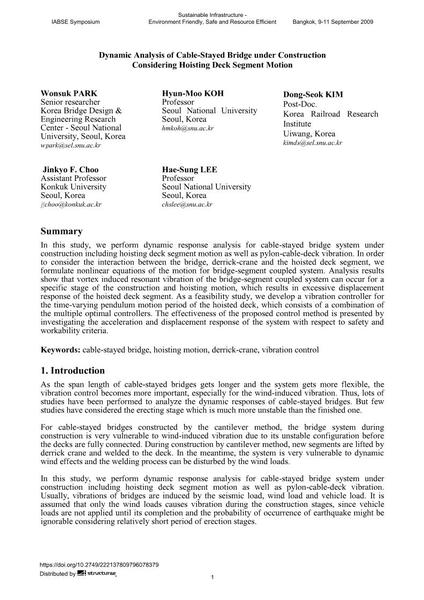Dynamic Analysis of Cable-Stayed Bridge under Construction Considering Hoisting Deck Segment Motion

|
|
|||||||||||
Détails bibliographiques
| Auteur(s): |
Wonsuk Park
Hyun-Moo Koh Dong-Seok Kim Jinkyo F. Choo Hae-Sung Lee |
||||
|---|---|---|---|---|---|
| Médium: | papier de conférence | ||||
| Langue(s): | anglais | ||||
| Conférence: | IABSE Symposium: Sustainable Infrastructure - Environment Friendly, Safe and Resource Efficient, Bangkok, Thailand, 9-11 September 2009 | ||||
| Publié dans: | IABSE Symposium Bangkok 2009 | ||||
|
|||||
| Page(s): | 1-10 | ||||
| Nombre total de pages (du PDF): | 8 | ||||
| Année: | 2009 | ||||
| DOI: | 10.2749/222137809796078379 | ||||
| Abstrait: |
In this study, we perform dynamic response analysis for cable-stayed bridge system under construction including hoisting deck segment motion as well as pylon-cable-deck vibration. In order to consider the interaction between the bridge, derrick-crane and the hoisted deck segment, we formulate nonlinear equations of the motion for bridge-segment coupled system. Analysis results show that vortex induced resonant vibration of the bridge-segment coupled system can occur for a specific stage of the construction and hoisting motion, which results in excessive displacement response of the hoisted deck segment. As a feasibility study, we develop a vibration controller for the time-varying pendulum motion period of the hoisted deck, which consists of a combination of the multiple optimal controllers. The effectiveness of the proposed control method is presented by investigating the acceleration and displacement response of the system with respect to safety and workability criteria. |
||||
| Mots-clé: |
Pont à haubans
|
||||
